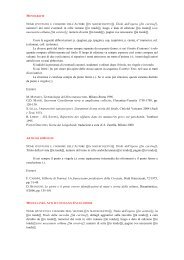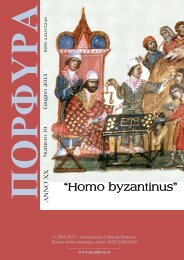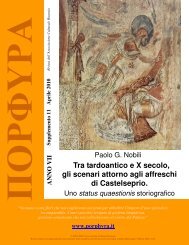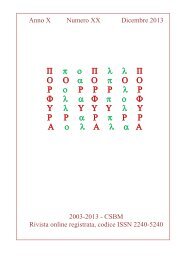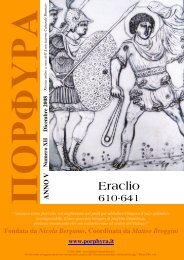ΠΟΡΦΥΡΑ - Porphyra
ΠΟΡΦΥΡΑ - Porphyra
ΠΟΡΦΥΡΑ - Porphyra
You also want an ePaper? Increase the reach of your titles
YUMPU automatically turns print PDFs into web optimized ePapers that Google loves.
A Prôtospatharios, Magistros, and Strategos Autokrator of 11 th cent.<br />
the equipment of Georgios Maniakes and his army according to the Skylitzes Matritensis miniatures<br />
and other artistic sources of the middle Byzantine period.<br />
comparison with the lateral details of the armour in folio 213v -<br />
possibly similar to those found in the Great Palace of<br />
Constantinople by the Scottish finds of Talbot Rice 72 (fig.6 n.<br />
2). These scale-coats looked really as scale- garments made of<br />
big superposed feathers : the way of fastening is hovewer<br />
difficult to understand. Looking in any case at the miniature of<br />
the Armenian Imperial Officer Johannes from the Armenian<br />
Adrianople Gospel of Venice, 73 we note that his κλιβανιον<br />
(even though this latter is lamellar so of a different type than the<br />
scale one worn by Maniakes) is fastened on the shoulders. Also<br />
the feathered armour should have a similar way of fastening, i.<br />
e. fastened on the shoulders by means of a system combining<br />
loops and buttons, as those used to fasten on the shoulders the<br />
sleeves of καβαδια mentioned by Praecepta Militaria I, 3<br />
(fig.6 n. 3-4) 74 . At lower borders of the corselet the miniature<br />
shows attached small kremasmata (tongues of the armour<br />
border, in ancient time kymation) 75 of coarse silk and cotton<br />
gold painted (fig.6 n. 1) 76 . For the πεταλα 77 (lamellae)<br />
72<br />
Talbot Rice, The Great Palace of the Byzantine Emperors, Edinburgh 1958, pp. 98-100 and pl. 58. This is the unique<br />
example of lamellar armour found until now in Constantinople. About the reconstruction of such a armour see Beatson<br />
P., Byzantine Lamellar armour ; Conjectural Reconstruction of a find from the Great Palace in Istanbul, based on<br />
early medieval parallels, in Varangian Voice n. 49 november 1998, pp. 3-8, and Nicolle, Arms and armour of the<br />
Crusading Era, 1050 - 1350, London, 1999, II Voll. pp. 38-39 and fig. 41.<br />
73<br />
See note 69 above ; the miniature shows us the Officer closed in parade armour i.e. a golden lamellar kλιβανιον and<br />
the officer sash around the breast.<br />
74<br />
κοµποθηλυκια ; s. Sylloge Tacticorum 38,4 ; Taktika of Nikephoros Ouranos, 56,3 in Mc Geer, Showing, cit. pp.<br />
89-163. Byzantine buttons of this period have been found both in Constantinople and in Corinth. See Hayes J.W.,<br />
Excavations at Sarachane, in Istanbul, Vol. II, Washington 1988, p. 263-264 and figg. 546-552. The n. 4 of fig. 6 is<br />
copied by n. 551. See also Davidson G.R., Corinth, the minor objects, Princeton 1952, 296-304, fig.2614-2634.<br />
75<br />
The word’s meaning is literally “hanging pieces” and it is used in Praecepta Militaria III, 4 and in the Taktika of<br />
Nikephoros Ouranos 60, 4 to indicate the padded and quilted skirts made of cotton or coarse silk (κουκολιον and<br />
βαµβακιον) hanging below a soldier’s cuirass to protect his legs. They looked apron like and this can explain the<br />
archaic Roman appearance of many warriors represented in the art, see for example the Triptych Harbaville in the<br />
Shuvalov Collection (Inv. Hermitage no. w ; s. Bank, Byzantine Art in the collections of the USSR, Leningrad-Moscow<br />
1985, ff. 126-131).<br />
76<br />
The big debate in East-Roman military matters is the question of the archaic aspect of some armours are they artistic<br />
licence reminiscence or do they really correspond to reality. Obviously the present author supports this second idea,<br />
based upon the observation that so many details of armour and weapons, in art, are so close to the contemporary<br />
archaeological evidence to exclude, in many cases, convention or a partial correlation to reality. For instance even the<br />
spears with a pommel under the point, as those represented in the Psalter of the Boulgaroktonos in Cod. Marc. Gr. 17<br />
have been found in Bulgaria (see Vitlyanov S., The Old Bulgarian Armament, Sofia 1996, pl. VII n. 15, in Bulgarian<br />
with English summary). So may be the representation of military subjects in Byzantine art is not the fruit of convention<br />
as many people said. My purpose is, in future contributions, to show the striking analogies among art and archaeology.<br />
The same concept should be applied for the shape of all kinds of armours shown in the miniatures, either if scale or<br />
lamellar Κλιβανια, thorakia or mail zabai : the unique way to solve this problem is a parallel use of art, archaeology<br />
and literature, not examined in a separate way. So sometimes, but not as a rule, the diffuse use of leather and felt and<br />
organic material as base for armour could have be done, sometimes, in the form presented by the East-Roman art, i.e.<br />
an archaic but desirable way to present the Roman heritage of the army. A kind of scale could also be worn over a<br />
muscled leather garment, because traditional does not always mean an obsolete type of armour. It is a fact that this<br />
argument is in any case very difficult to solve. The problem with the East-Roman armour is that very few fragments<br />
have been published or exposed, and the lack of archaeological specimens in felt or leather – together with the<br />
difficulty of finding military material in the old lands which were the heart of the Empire – complicates the question.<br />
Of course the true muscled leather (or metal) armour - which I believe as the late Mrs. Hoffmeyer (cf. The military<br />
Equipment pp. 52-55) still used in XII century (and may be also later) as shown by the Matritensis (see for instance the<br />
16



